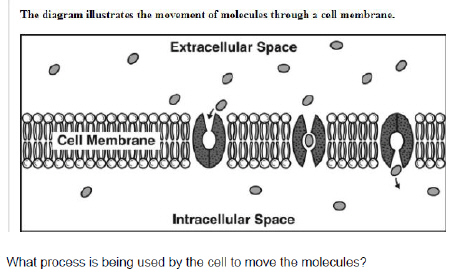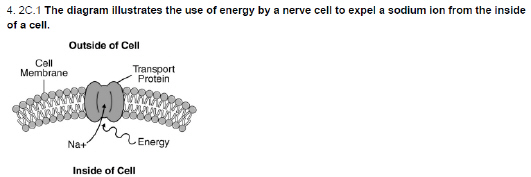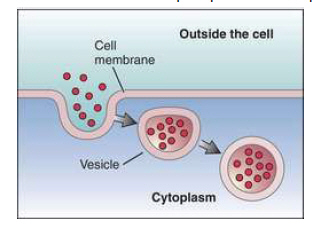Multiple Choice
Identify the
choice that best completes the statement or answers the question.
|
|
|
1.
|
2C.1 Which cellular structure in an animal cell helps maintain homeostasis by
controlling the transportation of substances into and out of the cell?
a. | Vacuole | b. | Cell wall | c. | Mitochondrian | d. | Cell membrane |
|
|
|
2.
|
2C.1  a. | Osmosis | b. | Endocytosis | c. | Active
Transport | d. | Facilitated Diffusion |
|
|
|
3.
|
2C.1 What will happen to a cell that is placed in a hypotonic saline
solution?
a. | Water will exit the cell causing it to shrink | b. | Water will enter the
cell causing it to swell. | c. | Salt will exit the cell causing it to
shrink. | d. | Salt will enter the cell causing it to swell. |
|
|
|
4.
|
 Which BEST explains why energy is
necessary to complete this function. a. | The ion is being transported against a concentration gradient. | b. | The ion has more
kinetic energy than the surrounding molecules. | c. | The ion is a waste product digested by the cell
membrane. | d. | The ion is too large to pass through the cell membrane by
diffusion. |
|
|
|
5.
|
a. | The volume of solution. | b. | The shape of the dye
molecules | c. | The temperature of the water. | d. | The concentration of the dye
molecules. |
|
|
|
6.
|
2C.1 The cell membranes allow some molecules to move freely across the cell
membrane while restricting others. What term BEST describes this capability of the cell
membrane?
a. | Semipermeable | b. | Impervious | c. | Resilient | d. | Unyeilding |
|
|
|
7.
|
2C.1 Which component of the cell membrane actively transports molecules into the
cell?
a. | Carbohydrate | b. | Protein | c. | Phospholipid | d. | Cytoplasm |
|
|
|
8.
|
a. | The cell was submerged in a pure solution. | b. | The cell was
submerged in a hypotonic solution. | c. | The cell was submerged in a hypertonic
solution. | d. | The cell was submerged in an isotonic solution. |
|
|
|
9.
|
2C2  a. | A contraction in blood vessels in the skin. | b. | Increasing waste
elimination from the bladder. | c. | Increasing the amount of
perspiration. | d. | A reduction in the desire for liquids. |
|
|
|
10.
|
2C.2 The production of sweat is typically a response to a body? ’s
increase in? ….
a. | Blood circulation | b. | Temperature | c. |
Respiration | d. | Heart Rate |
|
|
|
11.
|
2C.2 A lipid bilayer allows certain molecules to pass through, and blocks other
molecules. Which structure is most often protected by a lipid bilayer?
a. | Cell | b. | Tissue | c. | Organ | d. | Organ system |
|
|
|
12.
|
2C.2 Which transport process is depicted by this diagram? (Pay attention to
direction of arrows)  a. | Diffusion | b. | Exocytosis | c. | Endocytosis | d. | Osmosis |
|